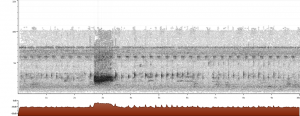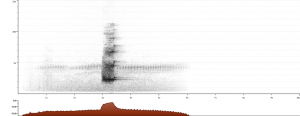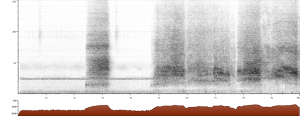Barn Owls do not hoot like most owls. However, they do have various types of calls. There are five main categories of calls: screams, snores, hisses, chirrups and twitters, and other calls. The scream category consists of the advertising call (a drawn-out gargling scream), the distress call (a series of drawn-out harsh screams), the warning call (high-pitched scream), and the purring call (quiet scream used by male to attract female to a nest site). Snores are self-advertising calls given mostly by females and nestlings. Hisses are long and loud; they are given repeatedly to intimidate predators. Chirrups and twitters are given by males when delivering food and by females when feeding young. Nestlings will often twitter when uncomfortable or quarreling with a nest mate. Other calls include the mobbing call (an explosive yell), copulation call (staccato squeal), and greeting call (used during courtship and food deliveries (Birds of North American Online).
There has not been much primary literature specifically addressing the question of whether or not vocalization in Barn Owls is learned or innate. However, much work has been done on the vocalizations of nestlings. Dreiss et al. (2014) found that the calls of nestlings have individual signatures that are used to recognize which siblings are motivated to compete for food. The most vocal individual in the absence of parents is the one that sees the food brought by parents. The ability of nestlings to vocally negotiate priority access to food resources suggests that barn owl calls are innate. Another experiment performed by Dreiss et al. (2013) found that nestlings have developed a mechanism to avoid calling simultaneously because overlapped calls are less efficient at deterring competition for food. In order to develop this kind of mechanism, one can assume that the nestlings already have the ability to make calls and do not need to learn, making Barn Owl calls innate. There are several other studies that found vocalizations in Barn Owls. Ruppli et al. (2013) observed that nestlings produce more calls of longer duration than their siblings to compete for priority access to the indivisible prey item their parents will deliver next. In another experiment by Ruppli et al. (2013), nestlings refrained from vocalizing to a larger extent when around fewer but more motivated nestmates than when competing against more numerous but less motivated nestmates.
There is no evidence that either proves or disproves that Barn Owl dialects exist. However, the fact that Barn Owls only vocalize in calls and that the structure of these calls are simple support the idea that Barn Owls do not have dialects among populations. However, an article by Moffat (1940) states that there have been accounts in some areas (specifically the counties Limerick and Clare of Ireland) where the Barn Owl is a rather silent bird. Moffat describes in his own accounts of Barn Owls in the County Wexford that these owls are worthy of the nickname “Screech Owl”. While this does not suggest that dialects exist, it might be evidence that some populations of Barn Owls are more vocal than others.
Barn Owl flight call and scream:
Barn Owl territorial call:
Hissing calls of Barn Owl nestlings:
(www.xeno-canto.org)
References:
Birds of North America Online
Dreiss, A.N., Ruppli, C.A., Oberli, F., et al. 2013. Barn owls do not interrupt their siblings. Animal Behavior 86: 119-126.
Dreiss, A.N., Ruppli, C.A., and Roulin, A. 2014. Individual vocal signatures in barn owl nestlings: does individual recognition have an adaptive role in sibling vocal competition? Journal of Evolutionary Biology 27: 63-75.
Moffat, C.B. 1940. The notes of the barn owl. The Irish Naturalists’ Journal 7: 289-292.
Ruppli, C.A., Dreiss, A.N., and Roulin, A. 2013. Efficiency and significance of multiple vocal signals in sibling competition. Evolutionary Biology 40: 579-588.
Ruppli, C.A., Dreiss, A.N., and Roulin, A. 2013. Nestling barn owls assess short-term variation in the amount of vocally competing siblings. Animal Cognition 16: 993-1000.
www.xeno-canto.org
blog post by Ellena and Grace




Hi I live on the island of Hawaii. For the past few months I have been hearing an unusual noise. And I would listen, go outside look around and wonder..what the heck is it. Best way to describe: its a screeching noise. It starts in the early evening, no idea when it stops.. am asleep. Well this morning as I was prepping breakfast: had all the kitchen windows open. All of a sudden I see a large object flying in front of the windows. I am at the kitchen sink and it hovers for a second and retreats. I run outside and realized it’s an owl. It was AMAZING, MAJESTIC and BEAUTIFUL. Now I know what that noise is at night.
BARN OWLS !! no barn needed.
August 18,2018
Christine Menolascina
Baker City, Oregon
Hi,
My little town is in Eastern Oregon, pop. 10,000 and I live in town, a residential area, with dogs, cats, kids all over and after many sleepless nights and a flyby one night down the middle of the street, I started to pay attention. That was about 6 years ago.
Most folks tend to be grumpy when a comment is made about the owls and I can see their point as I have never been subject to a Tree + Owl + Sounds not 20 feet from my window (every night) or The Black Lump(s) or constant Car Washing.
My Experience has been AWESOME! and has been the theme for any friendly gifts.
I can spot the Owls in the Trees in Daytime, I can usually spark a Owl Response Call or at least another Owl Fly Over when I Talk to the Owls in their Language (I have gotten better, Really) and when I play their sounds on the phone, day or night, they will fly.
I would love to chat